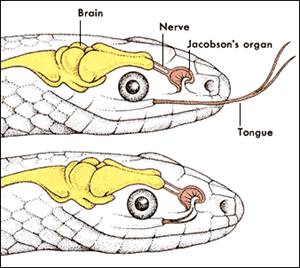
Coral Snake
Ancestory and Evolution
Body Structure
Eastern
Feeding
Reproduction
Western
Coral Snake The Senses
Snakes gather information about the world in a very different way from us. While we rely mostly on sight and hearing, these senses are relatively poorly developed in snakes. Instead they rely on other stimuli, particularly scents, and in some cases, heat.
Sight
Although all snakes are predators, their organs of sight are not very efficient. This anomaly may stem from their organs as primitive burrowing reptiles, evolved from burrowing lizards. Burrowing animals have little use for eyes and they tend to degenerate over a long period of time – various insects, amphibians, and fish that live in caves and other completely dark places demonstrate very well how this may come about.
Having returned to the surface, and therefore a well lit habitat, a later period in their history, the more advanced snakes had to re- invent the eye, although this had been achieved many of the more sophisticated features had been lost forever. You see, snakes are unable to change the shape of the lens of their eyes to focus, and they have no movable eyelids, giving them a large staring and unblinking gaze. The nocturnal snakes, like the coral snakes, have vertical slit pupils. This slit reduces the amount of light falling on the eyes light sensitive cells during the day.
Snakes are generally incapable of seeing detail, and in particular, stationary objects. On the other hand, a snakes eyes are highly sensitive to movement, and they have a wide field of view because of the position of the eyes on both sides of the head, this allows them to indicate activity that signals danger or a potential meal.
Hearing
Snakes are popularly thought to be deaf. This is not strictly true, because although they lack external ears, they do retain the vestiges of sound- transmitting equipment in a form of a small bone, the stapes. This bone is in contact with another bone that is in contact with the lower jaw, which is often in contact with the ground. Therefore, the snake is sensitive to vibrations, and in adition, low frequency airborne sounds that also cause vibrations may be detected by snakes.
One of the other reasons for why people believe snakes to be deaf is their lack of verbal communication. The sounds that they do produce – hisses, have evolved for them to communicate with other kinds of animals, as warnings.
Smell

Because snakes cannot see or hear well, they have developed their other senses. Of all the other senses, that of smell is probably the most important to snakes. Prey, predators, and members of the opposite sex are revealed to snakes by the scent chemicals they emit. The Jacobson organ, found only in snakes and some other lizards, works in conjunction with and in addition to, the nostrils and olfactory part of the brain. It is situated in front of the palate, and the sacs open to the roof of the mouth via a pair of narrow ducts.
When a snake wants to investigate its surroundings it flicks its tongue out, through a notch in the upper jaw known as the lingual fossa. The tongue picks up scents in the form of airborne molecules and is then withdrawn into the mouth. Active snakes use their tongue constantly and rely on the Jacobson’s organ even more than their nostrils.
Touch
The tongue is also used in the sense of touch, as are small tubercles, especially on the snout and chin. Tubercles are areas on the snakes where the cuticle is thinner. Nerve endings are concentrated in this region.All snakes are sensitive to temperature changes in their environment and to infrared radiation.